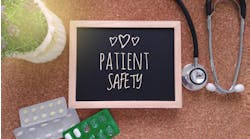Following a roundtable meeting held on September 18-20 in Chicago, with participation from the CMIOs and CNIOs of 26 major patient care organizations, the leaders at the Scottsdale Institute, a not-for-profit membership organization, produced a report entitled “Care Standardization: Why and How to Make this Work.” The report covers a range of issues that CNIOs and CMIOs are focused on in their patient care organizations nationwide.
Among the major concerns discussed at the meeting were care delivery standardization, reducing the cognitive burden on frontline clinicians, content management and clinical decision support, and clinician engagement and a culture of accountability.
Among the numerous findings in the final report, “There was consensus among the CNIOs that as the reliance upon the EMR has evolved, care standardization has fallen by the wayside. EMR vendors are hit-or-miss when it comes to designing products based on evidence-based practice and care standardization. Vendors have responded to user requests for more CDS tools and alerts and, more recently, predictive-analytics tools. However, without care standardization in mind, the industry is now backed into a corner: a complicated documentation structure within the EMR demands intensive entry of data elements that require data capture for the sake of measuring outcomes—not for patient care.”
What’s more, the report noted, “The one-two punch of EMR cognitive burden and the need to standardize care has driven the healthcare industry to step back and ask: “What are we really trying to do here?” Clinicians and informaticists alike agree we need to revisit best practices and eschew the obsession with embedding hard stops to drive care, all the while ensuring the right governance is in place to drive and approve care standards and associated documentation. This realization has spurred many health systems to begin to subtract documentation from their EMR design and refocus on the fundamentals of care both to reduce burden and standardize care.” Indeed, CNIOs and CMIOs are peeling back the EMR-documentation load to more deeply understand the root cause of cognitive burden. Many organizations have shifted focus to training and education especially to achieve “EMR mastery” of the skills to navigate and utilize the full potential of EMR.”
Among those participating in the gathering was Mary Beth Mitchell, R.N., the CNIO at the 24-hospital Texas Health Resources integrated health system, based in Arlington, Texas. Mitchell, who has been helping to lead clinical and operational transformation work at THR for years, spoke this week with Healthcare Innovation Editor-in-Chief Mark Hagland, regarding the topics that were discussed in Chicago in September, and the broader frame around them in the current U.S. healthcare landscape. Below are excerpts from their interview.
What were some of the most important aspects of the discussions at the September gathering, for you?
A lot of us—all of us—are on high-reliability journeys, so patient safety is paramount, and as part of that, decreasing variation is key to achieving high reliability. My approach to decreasing variability is designing solid workflows that work, and hardwiring them. Our program is called Reliable Care Blueprinting. It’s our program to standardize workflows, and decrease variation in care to patients. We’ve had really good success with some of our clinical outcomes.
So that’s what I brought into the discussion. It was interesting that there was a lot of talking among the CNIOs about onboarding new nurses, training them adequately in the workflows, to consistently provide care. In the course of the discussion around training, we were talking about mastery. As we train people, we barely scratch the surface on what’s possible. So how do we really achieve mastery? And there are some things that can be done to improve the clinicians’ skills, and the use of the tools available. We also talked about integration and interoperability, to decrease errors.
The thing that I was really focused on from my perspective, was around cognitive burden, a subject I’ve presented on quite a bit. My passion right now is how we decrease the cognitive burden, because we just keep piling things onto the clinicians. Interoperability is one thing. The other is predictive analytics, having predictive tools within the EHR that alert you to relevant elements about a patient. So that’s an early warning system. Our vendors are developing predictive tools; we have one for sepsis, we’re putting one in for falls. And then, mobility.
And the other thing is around clinical decision support tools. Don’t over-alert, but present people with information when they need it, and the last thing is around alarm management, getting rid of nuisance alarms. And then the last thing is, our vendors—all the big vendors are able now to look at and track how clinicians are spending their time, and can provide you tools to identify where they’re getting bottlenecked. We were able to identify flow sheet rules that weren’t being adequately documented, for example; so, some internal tools to help us.
Nurse-physician relations have undergone tremendous changes in the past decades, correct? Away from the old hierarchies, and towards true multidisciplinary team-based care delivery?
I’m an old nurse, so I can go back 40 years. I think there’s a lot of mutual respect now, and that’s nice to see. And I especially saw that in the summit, with the CNIOs and CMIOs together. There’s more of a partnership with CNIOs and CMIOs working together as a dyad. Even five or seven years ago, things didn’t feel equal in the discussion. One of the things that struck me in the summit is how we were equal. The nurses felt safe to bring up things. It wasn’t nurses bashing doctors and doctors dismissing nurses; it felt equal. In hospitals, over the past five to ten years, we’ve seen this gradual trend towards more respect, and more of a team approach. I remember courtesy policies created more than ten years ago; I haven’t heard of doctors disrespecting nurses in recent years.
Multidisciplinary, team-based care has changed that dynamic, yes?
Yes, we all need to be recognized for the skills we bring, without anyone being characterized as above anyone else. And I want to make sure we all remain respectful of each other. I certainly respect physicians for what they know, and I think they respect me for my knowledge.
Do you see any shifts taking place with regard to decreasing some of the burdens around clinical documentation for billing?
We still do a lot of documentation for regulatory and legal requirements. Perhaps we’re charging a bit differently, for bundled payments, etc. We are doing a lot of documentation to meet the regulatory requirements, and in case we’re audited, to confirm charges, etc. Physicians are responding to note bloat.
What can CNIOs do to improve documentation for everyone?
Interoperability is a big part of that. If you can move data from one system to another, you’re not augmenting that. There is flowsheet development. And we keep pulling in structured data and notes, and it keeps replicating itself. So better design and structure of notes. We’re still struggling with copy-paste in terms of reducing the amount of documentation, while still making sure it’s accurate. But as long as we’re still in this flowsheet world, I don’t know how that’s going to change. What’s the value of a care plan? Nursing has tried for years to create a care plan that’s meaningful, and yet at the end of the day, for a lot of nurses, it’s still an exercise that they just have to complete.
What does the entire journey look like over the next five years?
We’re seeing a shift from hospital-based care to population-based care, putting the patient at the center, and not just seeing things as encounters. There’s a lot of opportunity there around looking at the social determinants of health and managing chronic illness. I’ve started getting involved in some of our community-based programs, and doing a lot around social determinants of health. We’re starting to look at things like providing transportation to patients via Uber, etc. And that’s where we need to be heading. And I’m seeing a lot of EHR vendors creating new options. The use of registries, of data analytics.
Data analytics will be essential for success in value-based contracting?
It already is! Our contracts will be based on data, for sure. Our payers are going to be looking at our contracts in terms of our outcomes, and how we’re managing populations of patients, for sure.


